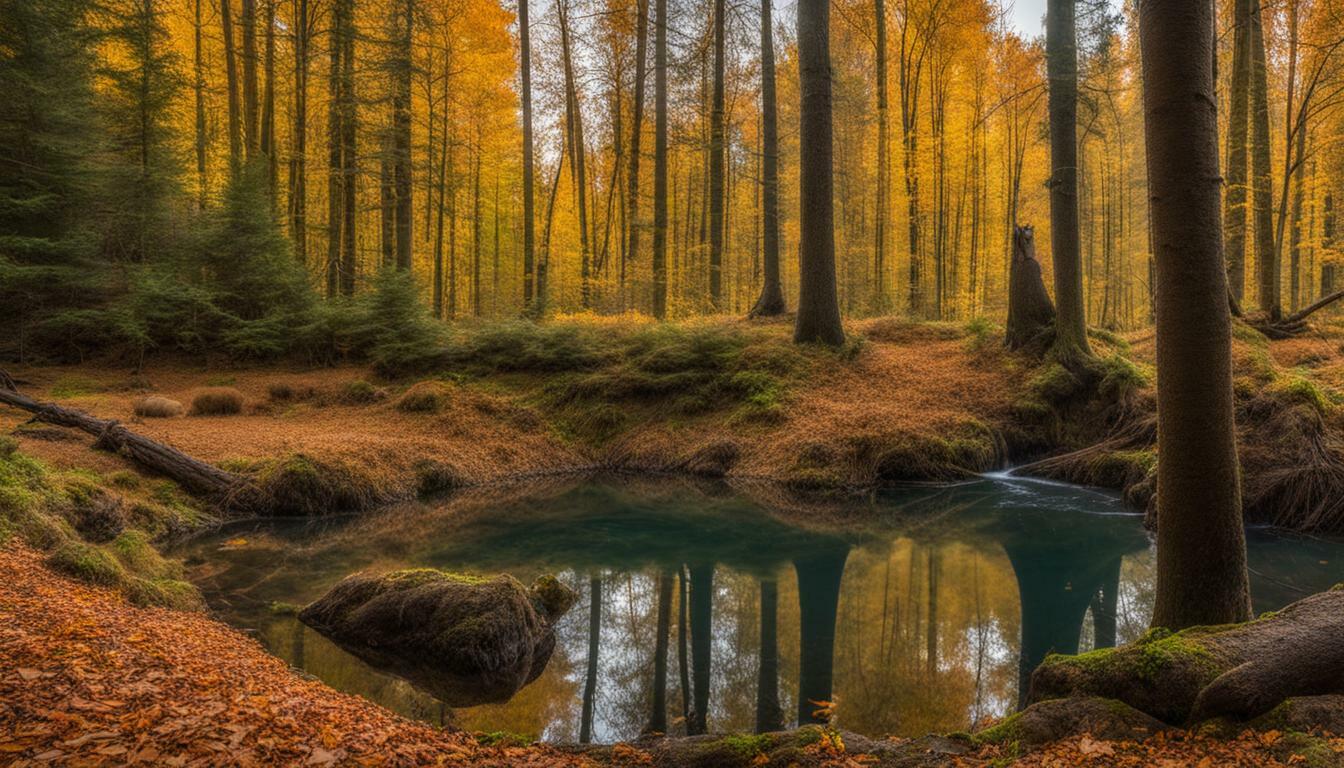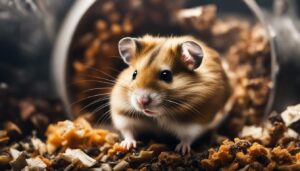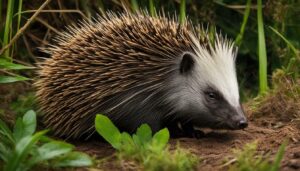Europe is home to a fascinating and diverse population of beavers, known as the Eurasian beavers. These remarkable creatures play a vital role in shaping their environments and supporting biodiversity. In this article, we will explore the presence of beavers in Europe, their habitat and distribution, population status, conservation efforts, threats they face, unique adaptations, and their significant impact on ecosystems.
The Eurasian beaver (Castor fiber) is a beaver species that was once widespread in Eurasia but faced near-extinction due to hunting. However, through reintroduction programs, they have made a remarkable comeback in many parts of Europe. Today, they can be found in various countries, including Spain, Central Europe, Great Britain, Scandinavia, and even regions in China and Mongolia. Classified as least concern on the IUCN Red List, the Eurasian beaver is considered a keystone species and an ecosystem engineer.
These beavers contribute to the creation of wetlands, providing habitats for a wide array of species and helping maintain the balance of ecosystems. In the UK, beavers have been reintroduced in select locations, offering an opportunity for their partial recovery after their extinction in the 16th century. Their dam-building behavior is renowned, as it not only creates floodplains but also increases foraging opportunities for themselves and other animals.
Eurasian beavers are herbivorous and have a varied diet, consisting mainly of plants such as water and riverbank plants, tubers, and softwood tree bark. They have a lifespan of around seven to eight years and typically breed from December to April, giving birth to litters of 2-3 kits in May or June.
Key Takeaways:
- Europe is home to the Eurasian beaver population.
- Eurasian beavers are keystone species and ecosystem engineers.
- They contribute to the creation of wetlands and provide habitats for various species.
- Beavers have been reintroduced in parts of the UK after facing extinction.
- Their dam-building behavior helps create floodplains and increases foraging opportunities.
European Beaver Facts
European beavers, scientifically known as Castor fiber, possess intriguing features and behaviors that make them a remarkable species. These herbivorous mammals play a crucial role in shaping their environment and supporting biodiversity. Here are some fascinating facts about European beavers:
- Physical Characteristics: European beavers are the largest rodents in Europe, measuring up to 3 feet in length and weighing around 40-70 pounds. They have dense, waterproof fur that varies in color from dark brown to reddish-brown, providing excellent insulation against cold water.
- Adaptations: One of the most remarkable adaptations of European beavers is their ability to construct elaborate dams using logs, sticks, and mud. These dams create intricate wetland ecosystems, which benefit various species and help regulate water flow. Additionally, beavers have webbed hind feet for efficient swimming and a specialized digestive system that allows them to digest tough plant materials.
- Behavior: European beavers are primarily nocturnal animals, spending their nights foraging for food and maintaining their dam constructions. They are highly territorial and mark their territories with scent markings, using glands located near their tails. Beavers are also known for their impressive engineering skills, as they construct intricate lodges made of branches and mud, providing safe havens for their families.
Eurasian Beaver Distribution in Europe
The Eurasian beaver (Castor fiber) was once widespread throughout Europe but was hunted to near-extinction for its fur and glandular secretions. However, through successful conservation efforts, the beaver has made a remarkable comeback in many European countries. Today, you can find European beavers in regions such as Spain, Central Europe, Great Britain, Scandinavia, and even as far as China and Mongolia.
In the United Kingdom, beavers have been reintroduced in various areas, including parts of Scotland, Devon, and Cornwall. These reintroduction programs aim to restore the ecological benefits that beavers provide, such as creating wetlands, supporting biodiversity, and mitigating flooding risks.
| Country/Region | Beaver Population |
|---|---|
| Spain | Approximately 20,000 |
| United Kingdom | Estimated 1,000 individuals |
| Central Europe | Population recovering, exact numbers unknown |
| Scandinavia | Several thousand individuals |
European beavers continue to thrive in various habitats and play a vital role in maintaining the health and balance of Europe’s ecosystems. Understanding these fascinating creatures and their unique adaptations can inspire us to appreciate and conserve their habitats for generations to come.
Beaver Habitat in Europe
European beavers have a wide range of habitat preferences and can be found in various aquatic ecosystems across Europe. These adaptable creatures are predominantly found in freshwater habitats such as rivers, streams, lakes, and wetlands. They are well-suited to both slow-moving and fast-flowing water sources, as long as there is ample vegetation for their feeding and construction needs.
Beavers are excellent engineers and builders, creating elaborate dams and lodges using branches, mud, and stones. These structures help regulate water levels and provide protection from predators. They prefer to construct their dams in areas with sufficient tree cover, as they rely on woody material for their building endeavors.
In addition to their dam-building activities, European beavers also create burrow systems in riverbanks. These burrows serve as secure nesting sites and provide refuge during extreme weather conditions or to escape from predators. The adaptability of European beavers allows them to thrive in a range of habitats, from deep forested areas to more open landscapes characterized by marshes and wet grasslands.
| Habitat | Features |
|---|---|
| Rivers | Slow-moving or fast-flowing water sources with ample vegetation |
| Lakes | Freshwater bodies with sufficient tree cover for dam-building |
| Wetlands | Marshes, meadows, and wet grasslands with access to water |
Beaver Adaptations in Europe
European beavers have developed remarkable adaptations that enable them to thrive in their aquatic habitats. Their webbed hind feet and paddle-shaped tail function as powerful tools for swimming and maneuvering in water. The tail also plays a crucial role in communication, creating distinct slapping sounds to warn other beavers of potential danger.
- Their sharp incisors, orange on the front, allow them to gnaw through tree trunks and branches, aiding their dam-building and feeding behaviors.
- Their ears and nostrils can be closed off underwater, allowing them to remain submerged for extended periods while foraging for food or working on their constructions.
- Their dense, waterproof fur keeps them warm in cold water and provides protection from moisture.
- Beavers have an impressive ability to modify their environment, creating wetlands that benefit numerous other species and enhance ecosystem biodiversity.
As ecosystem engineers, European beavers play a vital role in shaping and maintaining the aquatic ecosystems they inhabit. Their presence promotes the creation of wetlands, mitigates flooding, and provides habitats for various plant and animal species. By understanding their habitat preferences and adaptations, we can further appreciate the significance of European beavers in Europe’s natural environment.
Beaver Distribution in Europe
European beavers have a widespread distribution across Europe, with populations found in numerous countries and regions. The Eurasian beaver (Castor fiber), once hunted to near-extinction, has been successfully reintroduced in many parts of its former range. Today, these industrious creatures can be found in habitats spanning from Spain, Central Europe, Great Britain, and Scandinavia to regions in China and Mongolia.
In the United Kingdom, efforts have been made to reintroduce beavers in various locations. Once extinct in Britain by the 16th century, beavers have made a remarkable recovery and can now be found in parts of Scotland, Devon, Cornwall, and other areas. Their presence is beneficial to the ecosystem, as they engage in dam-building behavior, creating floodplains and providing increased foraging opportunities for a variety of species.
As herbivores, beavers primarily feed on plants, including water and riverbank plants, tubers, and softwood tree bark. With a lifespan of around seven to eight years, they reproduce from December to April and give birth to litters of 2-3 kits in May or June. These charismatic creatures are classified as least concern on the IUCN Red List and are recognized as keystone species and ecosystem engineers due to their ability to create wetlands and support biodiversity.
The Distribution of European Beavers in Different Countries
| Country | Region |
|---|---|
| Spain | Various regions, including Galicia and Catalonia |
| Germany | Bavaria, Brandenburg, and Saxony |
| United Kingdom | Scotland, Devon, Cornwall, and other areas |
| Sweden | Västerbotten, Norrbotten, and other regions |
| France | Brittany, Normandy, and other areas |
These are just a few examples of the countries where European beavers can be found. Their distribution across Europe highlights their adaptability and ability to thrive in various habitats, contributing to the natural diversity and ecological balance of the continent.
Beaver Population in Europe
European beavers, once hunted to near-extinction, have seen a remarkable recovery in their populations across Europe. Thanks to successful reintroduction programs and conservation efforts, these keystone species have begun to thrive once again. Today, the Eurasian beaver (Castor fiber) can be found in various countries and regions, from Spain and Central Europe to Great Britain and Scandinavia, extending all the way to parts of China and Mongolia.
The beaver’s return to Europe has had a positive impact on the ecosystem. These industrious animals are known for their dam-building behavior, which helps create wetlands and floodplains. These habitats provide important freshwater resources and support a diverse range of plant and animal species. The beavers’ ability to engineer their environment has made them crucial in maintaining biodiversity and promoting overall ecosystem health.
In the United Kingdom, beavers have been reintroduced in select areas, including parts of Scotland, Devon, and Cornwall. This reintroduction has been successful, with the beaver population gradually expanding since their extinction in Britain during the 16th century. Their presence has brought about positive changes, such as increased foraging opportunities and improved water quality.
| Beaver Facts | |
|---|---|
| Listed Species | Eurasian Beaver (Castor fiber) |
| Lifespan | Around 7-8 years |
| Breeding Season | December to April |
| Litter Size | 2-3 kits |
| Main Diet | Plants, including water and riverbank plants, tubers, and softwood tree bark |
The recovery of beaver populations in Europe is a testament to the effectiveness of conservation efforts and the potential for species recovery when given the opportunity. The continued protection of these remarkable creatures is crucial for preserving the delicate balance of our ecosystems and ensuring the long-term survival of these fascinating animals.
European Beaver Conservation
European beavers are the focus of conservation efforts aimed at preserving their populations and restoring their key role in ecosystems. The Eurasian beaver (Castor fiber) is a beaver species that was once widespread in Eurasia but was hunted to near-extinction. However, it has been successfully reintroduced in many parts of its former range, including Spain, Central Europe, Great Britain, Scandinavia, and regions in China and Mongolia.
Beavers are considered a keystone species and ecosystem engineer due to their remarkable ability to create wetlands, which in turn supports the ecosystem and provides habitat for various species. In the UK, beavers have been reintroduced in parts of Scotland, Devon, Cornwall, and other areas. These areas have seen the positive impact of beavers on the environment, including the creation of floodplains and increased foraging opportunities.
It is important to note that the Eurasian beaver is listed as least concern on the IUCN Red List, which means that conservation efforts have been successful in preventing its further decline. However, ongoing conservation initiatives are necessary to ensure the long-term survival and healthy populations of European beavers. These efforts include habitat protection, reintroduction programs, and addressing the threats they face, such as habitat loss, pollution, and conflicts with human activities.
| Conservation Efforts | Threats |
|---|---|
|
|
In conclusion, European beavers play a crucial role in maintaining healthy ecosystems and are the focus of conservation efforts across Europe. By protecting their habitats, reintroducing them into suitable areas, and addressing the threats they face, we can ensure the long-term survival of these remarkable creatures and the benefits they bring to our natural environment.
European Beaver Threats
Despite their conservation status, European beavers still face various threats that pose challenges to their survival. These threats predominantly arise from human activities and habitat degradation.
Habitat Loss
One of the primary threats to European beavers is habitat loss. As human populations expand and develop, wetlands and riverine habitats, which are crucial for beaver survival, are often drained, dammed, or converted for agricultural or urban use. This loss of suitable habitat can directly impact beaver populations by reducing their access to food and shelter.
Human Conflicts
As beavers naturally alter their environment by building dams and flooding areas, conflicts with human activities can arise. These conflicts often stem from the flooding of agricultural land, roadways, and infrastructure. In response, beavers may be trapped or killed, which can have detrimental effects on local populations. Finding sustainable solutions to minimize conflicts and promote coexistence is crucial for the long-term survival of European beavers.
| Threats | Impact |
|---|---|
| Habitat Loss | Reduces access to food and shelter |
| Human Conflicts | Can lead to trapping and killing of beavers |
| Pollution | Contaminates waterways and affects beaver health |
Pollution
Pollution, particularly water pollution, poses a threat to European beavers. Chemical runoff, including pesticides and pollutants from industrial activities, can contaminate waterways. These pollutants can negatively impact the health of beavers, affecting their reproduction, immune system, and overall well-being.
Efforts are being made to address these threats and promote the conservation of European beavers. Conservation organizations, government agencies, and local communities are working together to protect and restore beaver habitats, implement sustainable management practices, and raise awareness about the importance of these remarkable creatures for ecosystem health.
Beaver Species in Europe
Europe is home to several beaver species, with the Eurasian beaver being the most well-known and widespread. The Eurasian beaver (Castor fiber) is a remarkable species that was once nearly extinct due to hunting. However, conservation efforts and reintroduction programs have successfully restored its population in many parts of Europe. Today, these beavers can be found in regions ranging from Spain, Central Europe, and Great Britain to China and Mongolia.
Considered a keystone species and ecosystem engineer, the Eurasian beaver plays a crucial role in shaping and maintaining habitats. It is an adept dam builder, creating wetlands and floodplains that provide essential resources for various plants and animals. By altering the landscape, beavers help increase foraging opportunities, support biodiversity, and contribute to the overall health of ecosystems.
In the United Kingdom, beavers were once extinct but have made a partial recovery through successful reintroduction efforts. They can now be found in select areas of Scotland, Devon, Cornwall, and other regions. The beavers’ dam-building behavior has proven essential in creating diverse habitats, protecting against flooding, and promoting sustainable water management.
| Species | Habitat | Conservation Status |
|---|---|---|
| Eurasian Beaver (Castor fiber) | Rivers, streams, and lakes in Europe and Asia | Least Concern (IUCN Red List) |
| American Beaver (Castor canadensis) | North America | Least Concern (IUCN Red List) |
Eurasian beavers are herbivorous, primarily feeding on water and riverbank plants, tubers, and the bark of softwood trees. They have an average lifespan of seven to eight years and typically breed from December to April, giving birth to litters of 2-3 kits in May or June. With their significant presence in European ecosystems, these fascinating creatures continue to captivate nature enthusiasts and remind us of the importance of preserving and protecting the natural world.
Beaver Adaptations Europe
European beavers have evolved unique adaptations that allow them to survive and thrive in their aquatic environments. Their physical characteristics and behaviors make them highly efficient in navigating their watery habitats and building their distinctive dams.
One of the most remarkable adaptations of European beavers is their webbed hind feet and strong, rudder-like tail. These features enable them to be excellent swimmers, propelling through the water with precision and speed. Their webbed feet act like flippers, providing propulsion and maneuverability, while their tail serves as a stabilizer and steering mechanism.
Another notable adaptation is their ability to gnaw through trees with their powerful incisor teeth. Beavers’ front incisors are exceptionally strong and continuously grow throughout their lives. This adaptation allows them to fell trees and use the wood to construct their dams and lodges. The construction of dams creates ponds that provide protection against predators and easy access to food sources during winter months.
In addition to their physical adaptations, beavers also exhibit remarkable social behavior. They are cooperative animals that live in family groups known as colonies. Within a colony, beavers work together to build and maintain their dams and lodges. Each individual has specific roles and responsibilities, contributing to the overall success and survival of the group.
| Beaver Adaptations Europe |
|---|
| Webbed hind feet |
| Strong, rudder-like tail |
| Powerful incisor teeth |
| Continuously growing incisors |
| Cooperative social behavior |
These fascinating adaptations allow European beavers to thrive in their watery habitats and fulfill their crucial ecological role as ecosystem engineers. By creating wetlands and modifying their surroundings, beavers contribute to the overall health and diversity of the ecosystems they inhabit, making them an invaluable species for conservation efforts.
The Remarkable Role of Beavers in Europe’s Ecosystems
European beavers play a crucial role in shaping and enhancing the ecosystems they inhabit through their dam-building activities. These industrious creatures create intricate networks of dams, canals, and lodges, resulting in the creation of wetlands and the transformation of landscapes.
By constructing dams, beavers slow down the flow of water in rivers and streams, leading to the formation of ponds and floodplains. This helps to regulate water levels and prevents flooding during heavy rainfall. Additionally, these wetland habitats provide vital breeding grounds for amphibians, fish, and a variety of bird species.
Furthermore, beaver dams act as filters, trapping sediment and pollutants, which improves water quality. The structures also help to store water, preventing drought in dry periods and creating a reliable water source for wildlife. This is particularly essential for the survival of many species during hot summers and in areas where water scarcity is a concern.
| Beaver Impact on Ecosystems | Benefits |
|---|---|
| Creation of Wetlands | Enhanced biodiversity, flood prevention, and increased carbon storage |
| Water Regulation | Preventing flooding and drought, improving water quality |
| Habitat Creation | Providing shelter and food sources for various species |
| Erosion Control | Stabilizing riverbanks and reducing sedimentation |
The presence of beavers also contributes to the overall health and resilience of ecosystems. Their dam-building activities create diverse microhabitats, attracting a wide range of plant and animal species. These habitats support a rich variety of flora and fauna, including water-loving plants, invertebrates, and mammals, which in turn attract predators and enhance biodiversity.
Recognizing the importance of beavers, conservation efforts have been initiated across Europe to protect and restore their populations. By safeguarding these remarkable creatures and their habitats, we can ensure the continued benefits they bring to our ecosystems, from flood prevention to supporting a diverse array of wildlife.
Sources:
– IUCN Red List: https://www.iucnredlist.org/
– Scottish Natural Heritage: https://www.nature.scot/
– Wildlife Trusts: https://www.wildlifetrusts.org/
Conclusion
European beavers are a captivating species that have made a remarkable comeback in Europe, but their conservation remains essential to ensure their continued presence and the preservation of their valuable ecosystems.
The Eurasian beaver (Castor fiber) is a beaver species that was once widespread in Eurasia but was hunted to near-extinction. However, thanks to reintroduction efforts, these industrious animals can now be found in parts of Spain, Central Europe, Great Britain, Scandinavia, and even regions in China and Mongolia.
Listed as least concern on the IUCN Red List, the beaver is considered a keystone species and ecosystem engineer. They create wetlands, helping to support the ecosystem and providing habitat for various species. In the United Kingdom, beavers have been reintroduced in areas such as Scotland, Devon, and Cornwall, playing a crucial role in restoring local ecosystems.
Known for their remarkable dam-building behavior, beavers have the ability to create floodplains and increase foraging opportunities. These herbivorous creatures primarily feed on plants, including water and riverbank plants, tubers, and softwood tree bark. With a lifespan of around seven to eight years, beavers breed from December to April, giving birth to litters of 2-3 kits in May or June.
Despite their impressive recovery, the conservation of European beavers remains vital to ensure their long-term survival and the ecological benefits they provide. By protecting and managing their habitats, addressing threats such as habitat loss and pollution, and promoting coexistence with human activities, we can secure the future of these fascinating creatures and the ecosystems they shape.
FAQ
Are there beavers in Europe?
Yes, there are beavers in Europe. The Eurasian beaver (Castor fiber) is a beaver species that was once widespread in Eurasia but was hunted to near-extinction. However, it has been reintroduced in many parts of its former range and now occurs from Spain, Central Europe, Great Britain, and Scandinavia to regions in China and Mongolia.
What is the conservation status of the Eurasian beaver in Europe?
The Eurasian beaver is listed as least concern on the IUCN Red List. It is considered a keystone species and ecosystem engineer, as it creates wetlands, helps support the ecosystem, and provides habitat for various species.
Where have beavers been reintroduced in the UK?
Beavers have been reintroduced in parts of Scotland, Devon, Cornwall, and other areas in the UK. They were extinct in Britain by the 16th century but have since made a partial recovery.
What do beavers eat?
Beavers are herbivorous and mainly eat plants, including water and riverbank plants, tubers, and softwood tree bark.
What is the lifespan of a beaver?
Beavers have a lifespan of around seven to eight years.
When do beavers breed and give birth?
Beavers breed mainly from December to April and give birth to litters of 2-3 kits in May or June.




